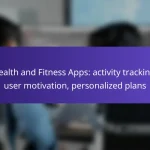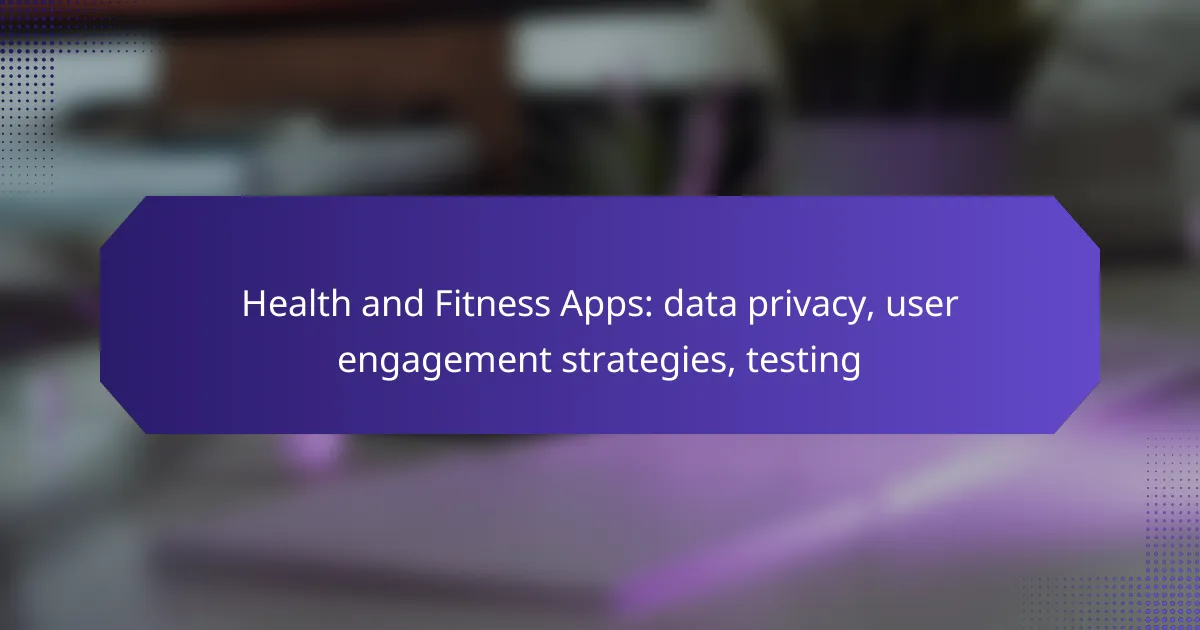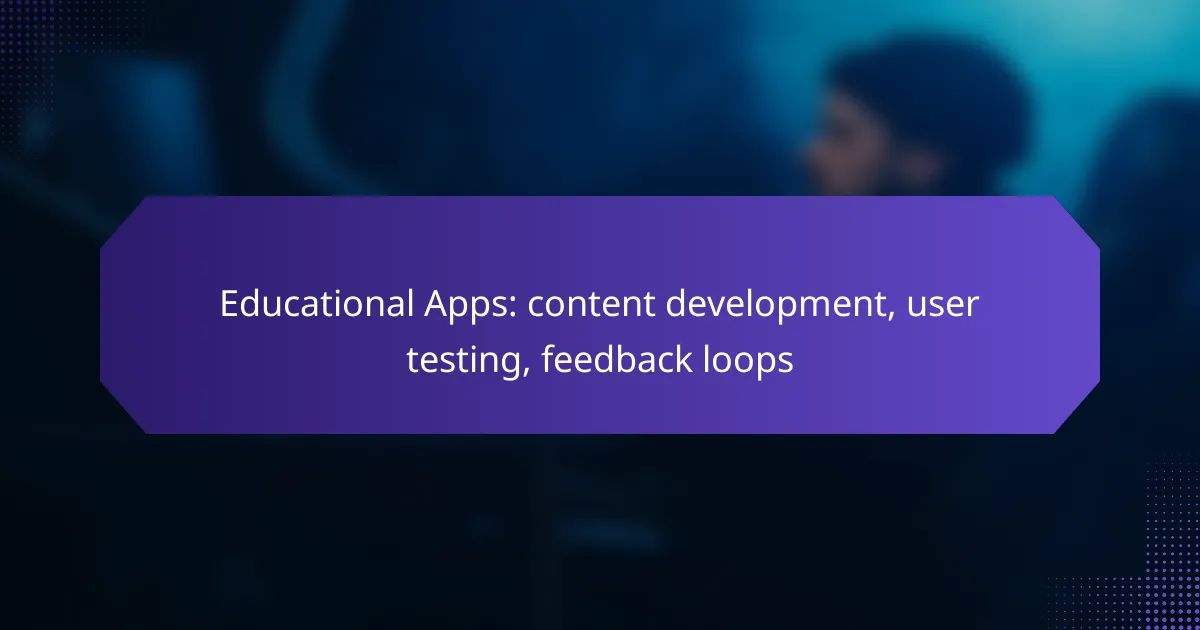Health and fitness apps are increasingly focusing on data privacy while offering features that enhance user engagement. By adhering to regulations such as GDPR and implementing robust security measures, these apps ensure that user data remains protected. Additionally, strategies like gamification and personalized notifications are employed to keep users motivated and connected within the app community.

What are the best health and fitness apps for data privacy in the UK?
Several health and fitness apps prioritize data privacy while providing effective tracking and engagement features. Users in the UK should consider apps that comply with GDPR regulations and offer transparent data usage policies.
MyFitnessPal
MyFitnessPal is a popular app for tracking diet and exercise, and it emphasizes user privacy by allowing users to control their data sharing preferences. The app does collect data for personalized experiences, but it provides clear options for users to manage their privacy settings.
To enhance privacy, users should regularly review their settings and limit the information shared with third-party integrations. MyFitnessPal also offers a premium version that includes additional privacy features.
Fitbit
Fitbit focuses on health tracking through wearables and its app, ensuring user data is protected under strict privacy policies. The company adheres to GDPR guidelines, which means users in the UK can expect robust data protection measures.
Fitbit allows users to customize their privacy settings, including who can see their activity and health data. Regularly updating the app and reviewing privacy settings can help maintain data security.
Strava
Strava is designed for athletes and fitness enthusiasts, offering features for tracking runs and rides. While it has a strong community aspect, users should be aware of the potential for data exposure, especially with location tracking.
To safeguard privacy, users can adjust their profile settings and choose to hide their activity from public view. Strava also provides a subscription option that includes enhanced privacy features.
Apple Health
Apple Health integrates data from various health and fitness apps while prioritizing user privacy. Apple employs strong encryption and local data storage, ensuring that sensitive health information remains secure.
Users can manage their health data sharing preferences directly within the app, allowing them to control which apps can access their information. Regularly reviewing these settings is advisable for maintaining privacy.
Google Fit
Google Fit offers a comprehensive platform for tracking fitness and health metrics, with a focus on user privacy. The app complies with GDPR and provides users with clear information about data collection and usage.
Users should take advantage of the privacy settings available in Google Fit, including the ability to manage data sharing with other apps. Regularly checking these settings can help ensure that personal data remains protected.
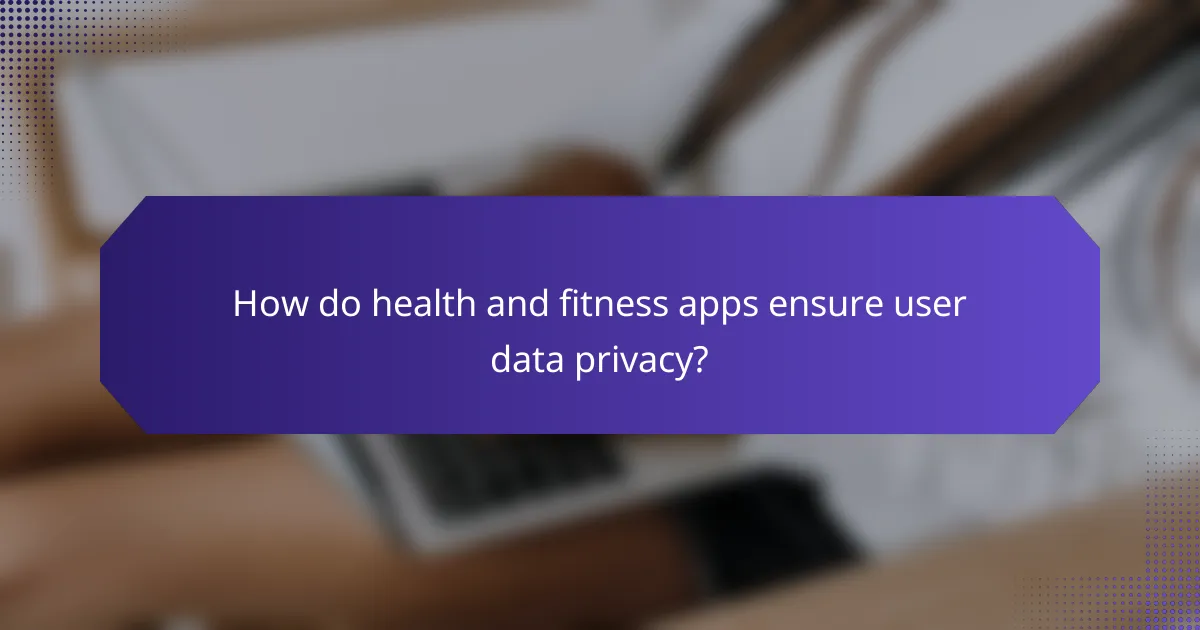
How do health and fitness apps ensure user data privacy?
Health and fitness apps prioritize user data privacy through various security measures and protocols. These strategies include end-to-end encryption, user consent protocols, and data anonymization techniques that collectively protect sensitive information.
End-to-end encryption
End-to-end encryption (E2EE) ensures that data is encrypted on the user’s device and only decrypted on the recipient’s device. This means that even if data is intercepted during transmission, it remains unreadable to unauthorized parties. Many health and fitness apps implement E2EE to safeguard personal health data, ensuring that only the user and authorized parties can access it.
For example, when a user logs their workout or health metrics, that data is encrypted before it leaves their device. Only the app’s server, with the correct decryption key, can access the original information. This significantly reduces the risk of data breaches.
User consent protocols
User consent protocols require apps to obtain explicit permission from users before collecting or sharing their data. This process often includes clear explanations of what data will be collected, how it will be used, and who it may be shared with. By adhering to these protocols, apps empower users to make informed decisions regarding their personal information.
Many apps present users with a consent form during the initial setup, detailing data usage policies. Users should carefully review these terms and can typically adjust their privacy settings later to limit data sharing or revoke consent entirely.
Data anonymization techniques
Data anonymization techniques involve removing or altering personally identifiable information from datasets, making it impossible to trace data back to individual users. This practice is crucial for health and fitness apps that analyze user data for trends without compromising privacy. Anonymized data can still provide valuable insights while protecting user identities.
For instance, an app might aggregate workout data from thousands of users to identify popular exercise trends without storing any individual user information. This approach not only enhances user privacy but also complies with regulations like the General Data Protection Regulation (GDPR) in Europe, which emphasizes data protection and user rights.

What user engagement strategies are effective for health and fitness apps?
Effective user engagement strategies for health and fitness apps include gamification, personalized notifications, and community features. These approaches help maintain user interest, promote consistent usage, and foster a sense of belonging among users.
Gamification elements
Gamification involves incorporating game-like features into health and fitness apps to motivate users. This can include rewards for completing workouts, earning badges for milestones, or leaderboards that foster competition among friends or community members.
To implement gamification effectively, consider using a point system where users earn points for various activities, such as logging workouts or achieving personal bests. This not only boosts engagement but also encourages users to set and reach goals.
Personalized notifications
Personalized notifications are tailored messages that remind users of their fitness goals, upcoming workouts, or achievements. These notifications can significantly enhance user engagement by providing timely prompts that encourage action.
For optimal effectiveness, notifications should be customized based on user preferences and behaviors. For example, sending reminders shortly before a scheduled workout or congratulating users on reaching a goal can make the experience more relevant and motivating.
Community features
Community features create a social environment within health and fitness apps, allowing users to connect, share experiences, and support each other. This can include forums, group challenges, or social media integration that encourages interaction among users.
To build a strong community, consider implementing features that allow users to share their progress, join challenges, or participate in group workouts. This sense of community can lead to increased accountability and motivation, making users more likely to stick with their fitness routines.
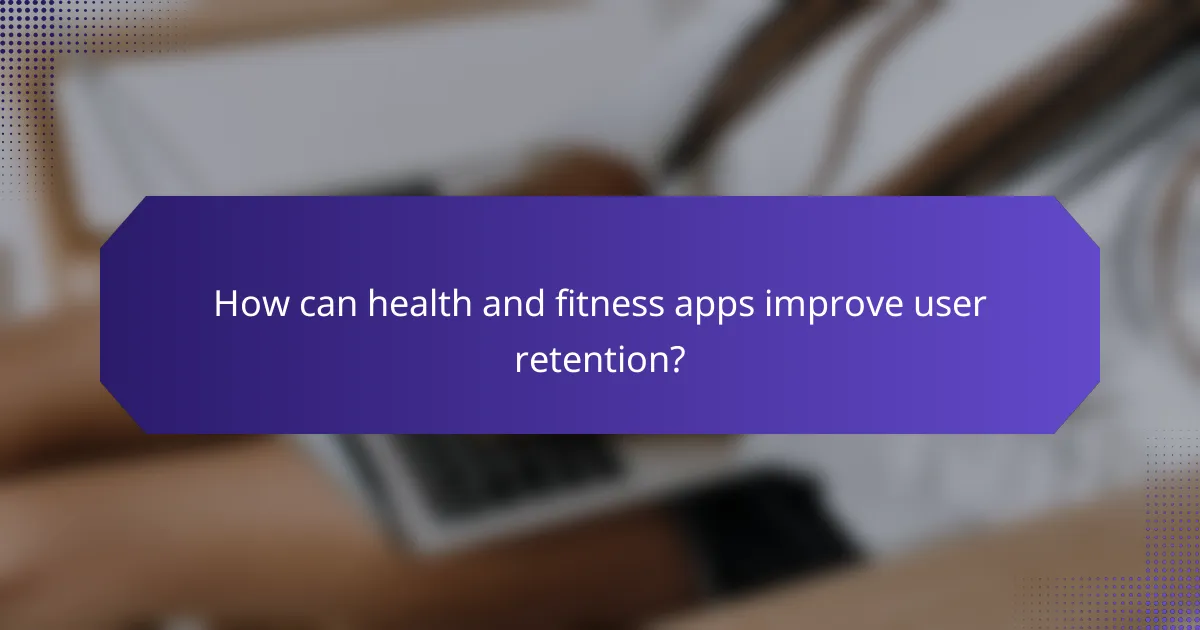
How can health and fitness apps improve user retention?
Health and fitness apps can enhance user retention by implementing strategies that keep users engaged and motivated. Regular updates, interactive challenges, and integration of user feedback are essential components that contribute to a more satisfying user experience.
Regular updates and new features
Regular updates and the introduction of new features are vital for maintaining user interest in health and fitness apps. Users appreciate fresh content, which can include new workout plans, dietary tips, or enhanced tracking capabilities. Keeping the app aligned with the latest health trends can significantly boost user engagement.
Consider scheduling updates quarterly or biannually to introduce significant changes while also providing minor updates monthly. This approach ensures users feel the app is evolving and meeting their needs.
In-app challenges and rewards
In-app challenges and rewards can effectively motivate users to stay engaged with health and fitness apps. By creating competitions, such as step challenges or workout streaks, users can feel a sense of accomplishment and community. Offering rewards, like badges or discounts on premium features, can further incentivize participation.
Implementing a tiered reward system can enhance motivation. For example, users could earn points for completing workouts, which can be redeemed for exclusive content or merchandise, fostering a sense of achievement and loyalty.
User feedback integration
Integrating user feedback is crucial for improving health and fitness apps and ensuring they meet user expectations. Actively soliciting feedback through surveys or in-app prompts allows developers to understand user preferences and pain points. This responsiveness can lead to higher satisfaction and retention rates.
Consider establishing a feedback loop where users can see how their suggestions have been implemented. This transparency not only builds trust but also encourages ongoing user engagement, as users feel their input is valued and impactful.
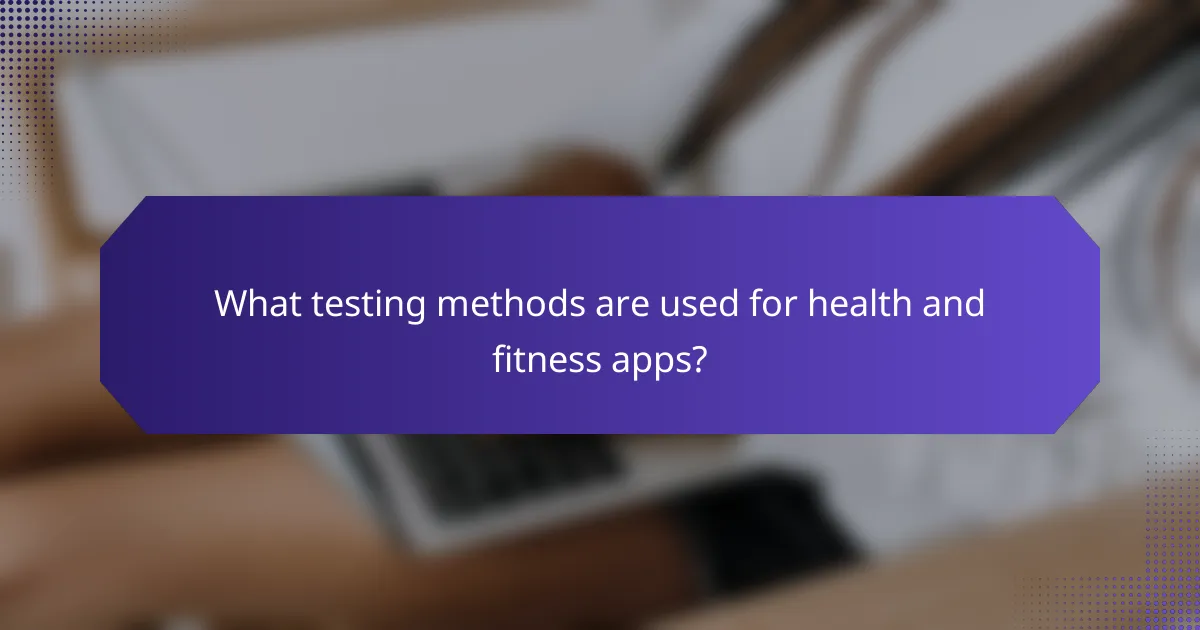
What testing methods are used for health and fitness apps?
Health and fitness apps utilize various testing methods to ensure functionality, user satisfaction, and performance. Key testing methods include A/B testing, user experience testing, and performance testing, each focusing on different aspects of the app’s effectiveness and user engagement.
A/B testing
A/B testing involves comparing two versions of an app to determine which one performs better in terms of user engagement and conversion rates. This method allows developers to test specific features, such as button colors or layout changes, by randomly assigning users to different versions.
When conducting A/B tests, it’s crucial to define clear metrics for success, such as click-through rates or user retention. Typically, a sample size of several hundred users is recommended to achieve statistically significant results.
User experience testing
User experience testing focuses on how real users interact with the app, identifying pain points and areas for improvement. This testing can be done through methods like usability testing, where participants complete tasks while observers note difficulties and feedback.
Incorporating user feedback early in the development process can enhance the app’s design and functionality. Aim for a diverse group of testers to gather a wide range of insights, ideally covering various demographics and fitness levels.
Performance testing
Performance testing assesses how well the app functions under various conditions, including load times and responsiveness. This testing is essential to ensure that the app can handle multiple users simultaneously without crashing or slowing down.
Key metrics to monitor include response times, memory usage, and battery consumption. Tools like Apache JMeter or LoadRunner can simulate user activity and help identify bottlenecks, ensuring a smooth experience for users across different devices and network conditions.

What are the key metrics for measuring user engagement?
Key metrics for measuring user engagement in health and fitness apps include daily active users, session length, retention rate, and user feedback. These metrics help developers understand how users interact with the app and identify areas for improvement.
Daily Active Users (DAU)
Daily Active Users (DAU) measures the number of unique users who engage with the app each day. A higher DAU indicates a strong user base and consistent engagement. Tracking DAU over time can reveal trends and the effectiveness of marketing strategies.
Session Length
Session length refers to the amount of time users spend on the app during a single visit. Longer session lengths often indicate that users find the app valuable and engaging. Aim for session lengths that average between 5 to 15 minutes, as this range typically reflects meaningful interaction without overwhelming users.
Retention Rate
Retention rate measures the percentage of users who continue to use the app over a specific period, such as a week or a month. High retention rates suggest that users find the app beneficial and are likely to recommend it to others. Strategies to improve retention include personalized content and regular updates.
User Feedback
User feedback is crucial for understanding user satisfaction and areas for improvement. Collect feedback through surveys, app store reviews, or in-app prompts. Regularly analyzing this feedback can help developers make informed decisions about features and enhancements that align with user needs.



